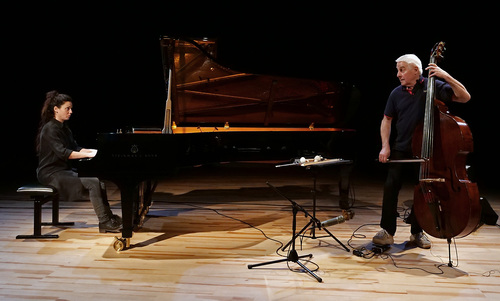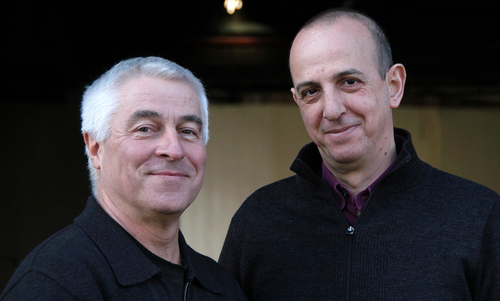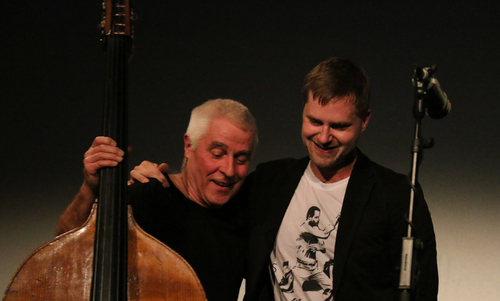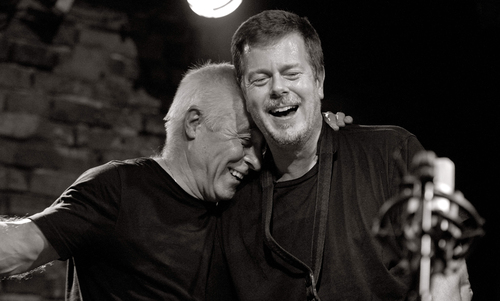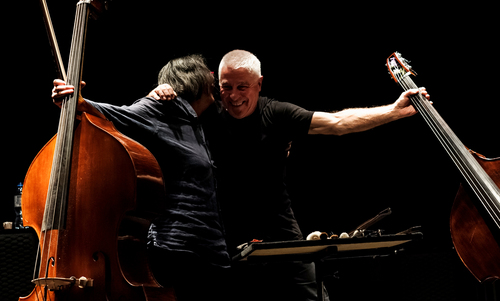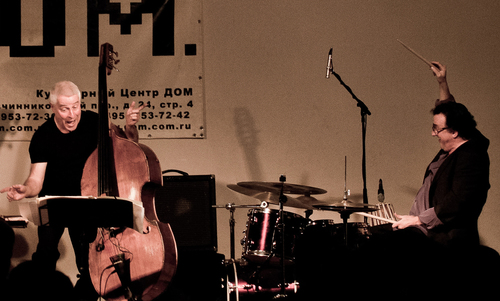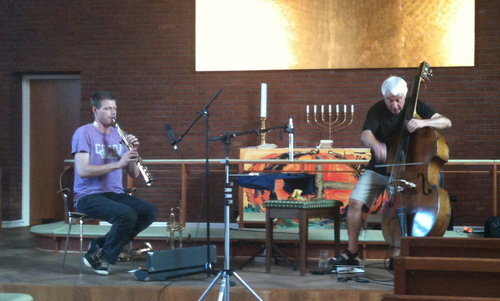For British bassist Barry Guy the concert that produced this fine double disc package occurred at the end of a four day intensive residency in Krakow culminating in the premier of an ambitious new work by his Blue Shroud Band. While for Chicago reedman Ken Vandermark, the event was the final episode in two months on the road. But whether relief or exhaustion were the dominant feelings, neither resulted in any lowering of standards or resting on laurels. Occasional Poems captures in unvarnished fidelity both sets in their entirety from the storied Alchemia club before a packed and enthusiastic audience.
Even at 67 years of age, Guy's trademark hyperkinetic style shows no sign of slowing. His lightning switches between registers, and between bowing, plucking and an array of implements to variously interrogate and cajole novel textures from the bass, remain very much in evidence. Such speed of thought is also mirrored in his responsiveness to Vandermark's ever-changing amalgam of percussiveness, lyricism, timbral investigation, and repetition, which tangentially evoke a range of genres amid an unfettered outpouring.
Pairings with reedmen have proven a familiar format for Guy over the years, as recordings with Torben Snekkestad, Mats Gustafsson, Liudas Mockunas and of course Evan Parker attest. But it's a less common scenario for Vandermark, and in fact this concert represents the first time just the two of them have taken to the stage. Nonetheless the album documents a very strong meeting of minds. Or should that be a meeting of very strong minds? The poems on this particular evening - seven duets and two soliloquies, all conjured spontaneously from the air - are bursting with ideas. They each pay close attention to what the other is doing and largely eschew oppositional strategies. And the outcome is all the more engaging as a result. In fact the opening "Nature is a Wolf" belts out of the gate in a such a relentless garrulous dash that even the listener is left gasping for air. The same maniacal energy manifests on "Light Cuts Shadow" where Vandermark shifts to clarinet for a spacey colloquy interrupted by sudden crescendos which gradually merge into another concentrated torrent.
Another highlight comes at the start of the second set on "States of Being" when Guy wields a brush, more like a drummer than a bassist, to accompany Vandermark's jagged swirling clarinet. It seems Vandermark's proclivity for insistent reiteration rubs off on Guy who is more rhythmic than usual throughout, but especially in "I Will Sing You of the Moments," a jerky exchange of tenor saxophone plosives and taut string thwacks.
Only rarely does one man overtly take the lead, but that's what happens in the last third of the otherwise turbulent "Riding the Air" where Guy initiates an intricately fingered bass coda against which Vandermark layers soothing sustained clarinet tones. But whatever the gambit, the music evolves in a bravura display of quick reflexes and inspiration.
(John Sharpe in All About Jazz)
Review by Colin Green
In November 2008, Ken Vandermark (reeds), Barry Guy (double bass) and Mark Sanders (drums) undertook a short tour of England. Two of the gigs, from Birmingham and Leeds, appeared on Fox Fire (Maya Recordings, 2009), one of Vandermark’s most impressive recordings where he rises to the challenge of playing with Guy and the new areas into which this pushed him.
Guy and Vandermark played again six years later in November 2014 at the Alchemia Club in Kraków during the ninth Autumn Jazz Festival, their first time as a duo. Guy was at the end of a week-long residency with his Blue Shroud band and Vandermark (who has a work ethic that puts the rest of us to shame) had agreed to the date at the end of over two months on the road, exhausted and travelling to the sound check direct from the airport. And yet, as is often the case with impromptu meetings in trying circumstances, as Vandermark says, “something special happened”.
On this album, we have nine of the pieces they performed over two sets. The titles have been provided by Guy, inspired by the poet Robert Lax, whose poems have distinctive layouts and make use of the repetition and permutation of a small body of words. According to Guy, “his singular focus on the world around his chosen space is indicative of the way improvisers work – gathering, analysing, inventing and trading ideas in the moments that we are allowed to express our art.” A fair general description of much of what’s going on with he and Vandermark, but works of abstract theatre that takes place in a rarefied realm, the nuances of which have no precise descriptive equivalent.
With Guy, one gets not just the standard dimensions – the melodic (horizontal) and chordal (vertical) – but the opening up of a third dimension in which shapes move and merge in a continual state of flux. The brilliant intensity of his playing has been likened to the flow of molten lava, the kind of thing that prompted Cecil Taylor to observe, “If I played bass I’d play the way you play”. Guy’s distinctive style is generated from the sonorities of his instrument and idiosyncratic actions (plucked, bowed, scraped, sometimes all three together) and the various treatments and devices he uses, resulting in a very personal vocabulary. But it’s also a language so rich – a sound world that has an almost visible texture, full of ridges, offshoots, nooks and crannies – that other musicians can’t fail but to be inspired. It probably helps not to think too much, and simply respond on a visceral level: exactly the condition of the weary Vandermark. Throughout, one feels the thrill of their having absolutely no idea where they’re going to end up.
At the most general level, these duos explore convergences and conflicts between two voices: communicative and non-communicative, sympathetic and contrasting. Right from the bell, they both go for it. ‘Nature is a Wolf’ is dominated by Guy’s repeated sliding chord, like an incessant cry, and Vandermark’s gnarled, hyper-compressed line. As the titles suggest ‘Light cuts Shadow’ and the ensuing ‘Shadow cuts Light’ can be seen as plays on positive and negative space, contrasting sides of the same thing. In the first, both instruments match each other in mood and texture as if mirroring different aspects of the same material: long, high notes, slithered bowing against rapid scales and leaps on the clarinet, ostinato figures locking them together, even a brief folksy episode. In the second piece the complimentary contrasts are this time in register, long resonant notes on the bass clarinet against dense spicatto and pizzicato on the bass. Roles are then reversed when Vandermark switches to the top end of his range and Guy descends to the lower. The remainder of the piece alternates between these two areas, with contrasting levels of energy. ‘I will Sing to You of The Moments’ is an exercise in perpetual motion, repeated patterns never quite symmetric, moving in and out of alignment and becoming more elaborate as the piece progresses.
There are times however, when Guy and Vandermark seem engaged in two distinct trains of thought, juxtaposed rather than in dialogue. On ‘States of Being’ which opens the second set, they start in the same place but rapidly move in different directions, wrapped in the virtuosic expansion of their own material, side by side, eventually acknowledging the presence of the other and returning to common ground, and finishing with a unison flourish.
Not only do relations change, so do characters and locations. Vandermark can move at will between different provinces in the landscape of free jazz, reflecting his wide-ranging interests, musical and otherwise. This means he doesn’t have a style so much as a series of self-imposed personae. He experiments, not with inclusiveness – trying to cover as much ground as possible – but by moderation, narrowing the range of ideas, colours and textures for each improvisation, the better to explore his chosen region, adjusting focus as he moves from one piece to the next. Vandermark is aware of the importance of boundaries. On ‘Pan Metron Ariston [Every Good Thing In Measure]’ (an old Greek saying) for tenor alone, he limits himself to a blues tune as the basis for a study in split notes, distortion and overtones, contrasted with staccato tonguing and key clatter, sounding a little like a combination of Mats Gustafsson and Peter Brötzmann, (with whom he’s played in the trio Sonore). In “Riding the Air’ there’s a continuous line of smeared gestures and phrases on bass clarinet, mainly in the lower registers, as if in mimicry of Guy’s bass which responds in like kind, resulting in mutual imitations. Broken off by Guy’s change of pace and a solemn plucked tune, Vandermark moves back providing gentle sustained notes in accompaniment as Guy’s melody and subtle harmonics sing with ever greater eloquence.
‘Black, White, Red, Blue’ is a bass solo, beginning with a simple succession of plucked glissandi notes which alternate with passages employing an ever increasing range of techniques and devices, below the bridge up to bouncing sticks threaded through the strings. Each time the glissandi notes return they become a richer melody, and as the two textural areas switch their opposition increases, perhaps reflected in the title – pairings of tonal opposites and complimentary colours.
The encore is ‘Curving of the Wave’, a series of quick-fire bursts and exchanges between tenor and bass suggesting that both players had been reinvigorated by their meeting.
(Colin Green)
St. Johann in Tirol Konzert
Barry Guy steht im Anschluss daran gleich wieder auf der Bühne, diesmal in völlig freihändiger Kommunikation mit dem universellen Saxofonisten und Klarinettisten Ken Vandermark. Glühende Zwiegespräche entstehen, einer Kerze gleichend, die an beiden Enden brennt. Das immense Vokabular beider friedlichen Kontrahenten erlaubt ein Klangspektrum, das durch die zeitweilige, Beckett'sche Verspieltheit Guys noch zusätzliche Impulse erfährt. Und allein das in mehrerlei Hinsicht halsbrecherische Klarinettenspiel Vandermarks sucht im Kontext der improvisierten wie der komponierten Musik ohnedies seinesgleichen.
(Freistil Magazin)
